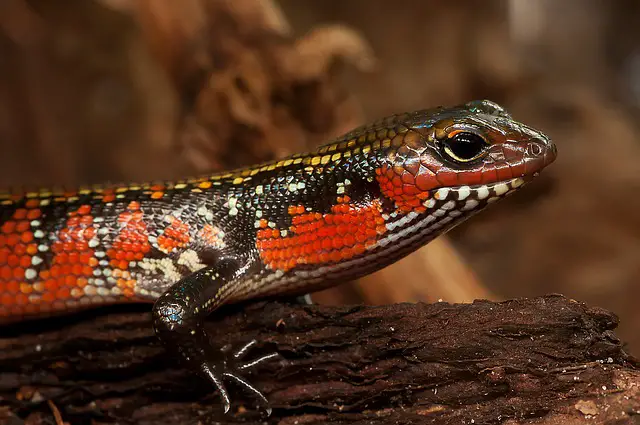Both fire skinks and blue tongue skinks are great reptiles for beginners, but there are some key differences between them, including appearance and temperament.
Fire skinks and blue tongue skinks are both interesting-looking reptilian pets with unique personalities, but which is the better skink to own? Let’s look a little closer at the friendliness of these skinks, their appearance, and how well they do make good pets.
Fire Skink Temperament
First up is the fire skink. This brightly patterned skink originally comes from Africa and is best known for its bright red-orange scales.
These skinks have a reputation for being shy, but they are reluctant to bite unless provoked. They can live in mated male and female pairs, or alone. Fire skinks, especially those caught in the wild, will be skittish and burrow under the substrate often until they become more secure in their environment.
Are Fire Skinks Friendly?
Fire skinks are calm reptiles, and once they are used to their owners and their surroundings, they can be friendly. You can handle a fire skink gently, and as long as they have gotten used to their home, they won’t mind being held.
Fire Skink Appearance
Fire skinks, on average, reach about 14-15 inches in length. They have a long body, stubby legs, red-orange sides, and a bronze back. Besides the bright sides and back, the rest of the fire skink is black, with the occasional white flecking. They get their name from the fiery color of their side scales.
Males and females are similar in size and appearance, with the males being slightly larger, with noticeable jowls as they age.
Do Fire Skinks Have Blue Tongues?
No. Unlike the blue tongue skink, the fire skink’s bright colors are on their body scales, not in their mouths.
Are Fire Skinks Hard To Care For As Pets?
Fire skinks are great for beginners and are relatively easy to feed and keep as pets.
Fire skinks eat easy-to-find live food like crickets and roaches. They need a 20-gallon enclosure for a single skink, but it’s best to do a 30 or 40-gallon tank for a mated pair. These skinks love live plants, and warm, moist air.
The only part of the fire skink’s enclosure that requires extra work is its substrate. These skinks love to burrow, so provide them with 6 inches of substrate that must stay moist at all times.
It’s also important to note that fire skinks can live up to a whopping 20 years! So while these skinks are easy pets to keep, they are a very long commitment.
Blue Tongue Skink Temperament
A bit larger, and less striking in appearance, is the blue tongue skink. This skink, native to the Australian desert, is a very popular reptilian pet that may seem dull to look at until they open their mouth and display their bright blue tongues.
Bluetongue skinks are docile, and if they are handled regularly, they will become more sociable. If not, they tend to hide often.
Bluetongue skinks can’t live with one another, or with other lizards, because they will become aggressive.
Are Blue Tongue Skinks Friendly?
If they are handled every day or every few days, the blue tongue skink can be friendly. If not, they may become more standoffish and even hiss when disturbed.
That being said, with regular attention, the blue tongue skink is one of the friendliest skinks you can own. Just make sure to put the time in to get the skink used to being held and touched.
Blue Tongue Skink Appearance
Compared to the petite fire skink, the blue tongue skink can get quite hefty! They are around 20-24 inches long.
The most striking feature of the blue tongue skink is, of course, their bright blue tongue. Bluetongue skinks use their tongue as a warning to predators and other lizards, sticking it out and hissing to scare them away. In captivity, you’ll get a good look at this tongue during feeding time.
Besides the tongue, blue tongue skinks have a more subdued coloring, with their scales ranging from grey to green.
There is no marked difference between male and female blue tongue skinks. Both have long bodies with short necks and stubby legs.
Do Blue Tongue Skinks Really Have Blue Tongues?
Yes! Bluetongue skinks have a bright blue tongue they use to warn other animals to leave them alone.
Are Blue Tongue Skinks Hard To Care For As Pets?
Bluetongue skinks are easy to care for and feed, but they have specific enclosure needs.
These skinks have a varied diet of fruits and insects, making them one of the easier to feed skinks as they don’t need to have live food all the time.
They need a large enclosure even though you can only keep one at a time. The ideal size is between 40 and 60 gallons. Since they like to spend their days hiding in their tanks, provide plenty of plants and logs for them to feel comfortable.
Bluetongue skinks are also long-term pets, living up to 15 years.
Which is the Better Pet: Fire Skink or Blue Tongue Skink?
Both fire skinks and blue tongue skinks make great pets for beginners and expert reptile lovers alike. Their habitats and diets aren’t particularly demanding, and with proper care, they are quite friendly.
If we had to choose which skink makes a better pet, the blue tongue skink wins just because of how easy they are to keep. No matter which one you choose, remember that they are a long-term commitment!




